Optimization of Mono-Crystalline Silicon Solar Cell Devices Using PC1D Simulation
Abstract
:1. Introduction
- Highly-doped emitter reduces the cell efficiency, and the cell efficiency is increased by reducing its dopant density between the front metal connectors.
- The 2D or 3D patterning simulation of dopant and contact region allows the rear surface to bear a larger potential for improved solar cell efficiency.
- The solar cell efficiency of the solar panel is directly proportional to the design optimization, and this indicates the need for the development of an accurate numerical model to simulate the solar cell
2. Simulation of Solar Cell Using PC1D
3. Results and Discussion
3.1. Determining the Optimal Wafer Thickness
3.2. Determining the Optimal Emitter Doping Concentration
3.3. Determining the Optimal Bulk Doping Level
3.4. Determining the Optimal BSF Doping Level
3.5. Determining the Optimal Bulk Lifetime with Shallow and Heavy Doping
3.6. Determining the Optimal Front and Back Surface Recombination Velocity
4. Conclusions
Author Contributions
Funding
Institutional Review Board Statement
Informed Consent Statement
Acknowledgments
Conflicts of Interest
References
- Andreani, L.C.; Bozzola, A.; Kowalczewski, P.; Liscidini, M.; Redorici, L. Silicon solar cells: Toward the efficiency limits. Adv. Phys. X 2019, 4, 1548305. [Google Scholar] [CrossRef] [Green Version]
- Altermatt, P.P. Models for numerical device simulations of crystalline silicon solar cells—A review. J. Comput. Electron. 2011, 10, 314–330. [Google Scholar] [CrossRef]
- Clugston, D.A.; Basore, P.A. PC1D version 5: 32-bit solar cell modeling on personal computers. In Proceedings of the Conference Record of the Twenty Sixth IEEE Photovoltaic Specialists Conference, Anaheim, CA, USA, 29 September–3 October 1997; pp. 207–210. [Google Scholar]
- Basore, P.A. Numerical modeling of textured silicon solar cells using PC-1D. IEEE Trans. Electron Devices 1990, 37, 337–343. [Google Scholar] [CrossRef]
- Basore, P.A.; Clugston, D.A. PC1D version 4 for Windows: From analysis to design. In Proceedings of the Conference Record of the Twenty Fifth IEEE Photovoltaic Specialists Conference, Washington, DC, USA, 13–17 May 1996; pp. 377–381. [Google Scholar]
- Park, C.; Balaji, N.; Ahn, S.; Park, J.; Cho, E.C.; Yi, J. Effects of tunneling oxide defect density and inter-diffused carrier concentration on carrier selective contact solar cell performance: Illumination and temperature effects. Sol. Energy 2020, 211, 62–73. [Google Scholar] [CrossRef]
- Park, C.; Ahn, S.; Kim, B.; Song, K.; Choi, J.; Balaji, N.; Ju, M.; Lee, H.; Yi, J. An Analysis and Optimization of Selective Emitter with Etched-Back Structure of Crystalline Silicon Solar Cells Using TCAD Simulation. J. Comput. Theor. Nanosci. 2013, 10, 1772–1778. [Google Scholar] [CrossRef]
- Khokhar, M.Q.; Hussain, S.Q.; Pham, D.P.; Lee, S.; Park, H.; Kim, Y.; Cho, E.C.; Yi, J. Simulation of Silicon Heterojunction Solar Cells for High Efficiency with Lithium Fluoride Electron Carrier Selective Layer. Energies 2020, 13, 1635. [Google Scholar] [CrossRef] [Green Version]
- Park, H.; Khokhar, M.Q.; Cho, E.C.; Ju, M.; Kim, Y.; Kim, S.; Yi, J. Computer modeling of the front surface field layer on the performance of the rear-emitter silicon heterojunction solar cell with 25% efficiency. Optik 2020, 205, 164011. [Google Scholar] [CrossRef]
- Shanmugam, V.; Khanna, A.; Basu, P.K.; Aberle, A.G.; Mueller, T.; Wong, J. Impact of the phosphorus emitter doping profile on metal contact recombination of silicon wafer solar cells. Sol. Energy Mater. Sol. Cells 2016, 147, 171–176. [Google Scholar] [CrossRef]
- Padhamnath, P.; Wong, J.; Nagarajan, B.; Buatis, J.K.; Ortega, L.M.; Nandakumar, N.; Khanna, A.; Shanmugam, V.; Duttagupta, S. Metal contact recombination in monoPoly™ solar cells with screen-printed & fire-through contacts. Sol. Energy Mater. Sol. Cells 2019, 192, 109–116. [Google Scholar]
- Padhamnath, P.; Buatis, J.K.; Khanna, A.; Nampalli, N.; Nandakumar, N.; Shanmugam, V.; Aberle, A.G.; Duttagupta, S. Characterization of screen printed and fire-through contacts on LPCVD based passivating contacts in monoPoly™ solar cells. Sol. Energy 2020, 202, 73–79. [Google Scholar] [CrossRef]
- Shanmugam, V.; Mueller, T.; Aberle, A.G.; Wong, J. Determination of metal contact recombination parameters for silicon wafer solar cells by photoluminescence imaging. Sol. Energy 2015, 118, 20–27. [Google Scholar] [CrossRef]
- Fell, A.; Altermatt, P.P. A detailed full-cell model of a 2018 commercial PERC solar cell in Quokka3. IEEE J. Photovoltaics 2018, 8, 1443–1448. [Google Scholar] [CrossRef]
- TCAD Sentaurus. Synopsys Sentaurus Structure Editor User Guide; Spatial Corp.: Mountain View, CA, USA, 2013; pp. 1–834. [Google Scholar]
- Silvaco, Int. ATLAS User’s Manual; Silvaco Int.: Santa Clara, CA, USA, 2010; Volume 3. [Google Scholar]
- Obrecht, M.S. MicroTec-3.00 for Windows: Educational semiconductor process and device simulator. In Proceedings of the 1998 Second IEEE International Caracas Conference on Devices, Circuits and Systems, ICCDCS 98, On the 70th Anniversary of the MOSFET and 50th of the BJT. (Cat. No. 98TH8350). Isla de Margarita, Venezuela, 4 March 1998; pp. 42–45. [Google Scholar]
- Sara, B.; Baya, Z.; Zineb, B. Investigation of Cu (In, Ga) Se2 solar cell performance with non-cadmium buffer layer using TCAD-SILVACO. Mater. Sci. Pol. 2018, 36, 514–519. [Google Scholar] [CrossRef] [Green Version]
- Schwartz, R.J.; Lundstrom, M.S.; Nasby, R. The degradation of high-intensity BSF solar-cell fill factors due to a loss of base conductivity modulation. IEEE Trans. Electron Devices 1981, 28, 264–269. [Google Scholar] [CrossRef]
- Lundstrom, M.S. Numerical Analysis of Silicon Solar Cells. Ph.D. Thesis, Purdue University, West Lafayette, ID, USA, 1980. [Google Scholar]
- Girardini, K.J.; Jacobsen, S. Optimization Methods for Numerical Silicon Solar Cell Models. Ph.D. Thesis, University of California, Los Angeles, CA, USA, 1986. [Google Scholar]
- Kane, D.; Swanson, R. The effect of excitons on apparent band gap narrowing and transport in semiconductors. J. Appl. Phys. 1993, 73, 1193–1197. [Google Scholar] [CrossRef]
- Cheng, D.Y.; Hwang, C.G.; Dutton, R.W. PISCES-MC: A multiwindow, multimethod 2-D device simulator. IEEE Trans. Comput. Aided Des. Integr. Circuits Syst. 1988, 7, 1017–1026. [Google Scholar] [CrossRef]
- Gray, J.L. Adept: A general purpose numerical device simulator for modeling solar cells in one-, two-, and three-dimensions. In Proceedings of the The Conference Record of the Twenty-Second IEEE Photovoltaic Specialists Conference, Las Vegas, NV, USA, 7–11 October 1991; pp. 436–438. [Google Scholar]
- Liang, M.; Law, M.E. An object-oriented approach to device simulation-FLOODS. IEEE Trans. Comput. Aided Des. Integr. Circuits Syst. 1994, 13, 1235–1240. [Google Scholar] [CrossRef]
- Fossum, J.; Sarkar, D.; Mathew, L.; Rao, R.; Jawarani, D.; Law, M. Back-contact solar cells in thin crystalline silicon. In Proceedings of the 2010 35th IEEE Photovoltaic Specialists Conference, Honolulu, HI, USA, 20–25 June 2010; pp. 003131–003136. [Google Scholar]
- Jimeno, J.; Uriarte, S.; Zamora, J.; Icaran, C. New Concepts in 2-Dimensional Solar Cell Modeling. In Proceedings of the Tenth EC Photovoltaic Solar Energy Conference, Lisbon, Portugal, 8–12 April 1991; pp. 75–78. [Google Scholar]
- Bank, R.E.; Rose, D.J.; Fichtner, W. Numerical methods for semiconductor device simulation. SIAM J. Sci. Stat. Comput. 1983, 4, 416–435. [Google Scholar] [CrossRef]
- Muller, S.; Kells, K.; Fichtner, W. Automatic rectangle-based adaptive mesh generation without obtuse angles. IEEE Trans. Comput. Aided Des. Integr. Circuits Syst. 1992, 11, 855–863. [Google Scholar] [CrossRef]
- Glunz, S.; Schumacher, J.; Warta, W.; Knobloch, J.; Wettling, W. Solar cells with mesh-structured emitter. Prog. Photovolt. Res. Appl. 1996, 4, 415–424. [Google Scholar] [CrossRef]
- Granek, F.; Hermle, M.; Huljić, D.M.; Schultz-Wittmann, O.; Glunz, S.W. Enhanced lateral current transport via the front N+ diffused layer of n-type high-efficiency back-junction back-contact silicon solar cells. Prog. Photovolt. Res. Appl. 2009, 17, 47–56. [Google Scholar] [CrossRef]
- Mihailetchi, V.; Geerligs, L.; Komatsu, Y.; Buck, T.; Röver, I.; Wambach, K.; Knopf, C.; Kopecek, R. High efficiency industrial screen printed n-type mc-si solar cells with front boron emitter. In Proceedings of the 22th European Photovoltaic Solar Energy Conference, Milan, Italy, 3–7 September 2007; pp. 1581–1585. [Google Scholar]
- Sepeai, S.; Zaidi, S.H.; Desa, M.; Sulaiman, M.; Ludin, N.; Ibrahim, M.A.; Sopian, K. Design optimization of bifacial solar cell by PC1D simulation. Parameters 2013, 3, 5. [Google Scholar]
- Meenakshi, S.; Baskar, S. Design of multi-junction solar cells using PC1D. In Proceedings of the 2013 International Conference on Energy Efficient Technologies for Sustainability, Nagercoil, India, 10–12 April 2013; pp. 443–449. [Google Scholar]
- Huang, H.; Lv, J.; Bao, Y.; Xuan, R.; Sun, S.; Sneck, S.; Li, S.; Modanese, C.; Savin, H.; Wang, A.; et al. 20.8% industrial PERC solar cell: ALD Al2O3 rear surface passivation, efficiency loss mechanisms analysis and roadmap to 24%. Sol. Energy Mater. Sol. Cells 2017, 161, 14–30. [Google Scholar] [CrossRef]
- Li, X.; Lee, K.R.; Wang, A. Chemical bond structure of metal-incorporated carbon system. J. Comput. Theor. Nanosci. 2013, 10, 1688–1692. [Google Scholar] [CrossRef]
- Choi, J.; Song, K.; Balaji, N.; Park, C.; Ju, M.; Ahn, S.; Lee, H.; Yi, J. A Simulation Study on the Shallow Emitter Sheet Resistance for Selective Emitter Crystalline Silicon Solar Cell with Screen Printed Etched Back Process. J. Comput. Theor. Nanosci. 2013, 10, 1767–1771. [Google Scholar] [CrossRef]
- Sopian, K.; Cheow, S.; Zaidi, S. An overview of crystalline silicon solar cell technology: Past, present, and future. AIP Conf. Proc. 2017, 1877, 020004. [Google Scholar]
- Haug, H.; Greulich, J. PC1Dmod 6.2–Improved simulation of c-Si devices with updates on device physics and user interface. Energy Procedia 2016, 92, 60–68. [Google Scholar] [CrossRef]
- Hashmi, G.; Akand, A.R.; Hoq, M.; Rahman, H. Study of the enhancement of the efficiency of the monocrystalline silicon solar cell by optimizing effective parameters using PC1D simulation. Silicon 2018, 10, 1653–1660. [Google Scholar] [CrossRef]
- Cuevas, A.; Sinton, R.A. Characterisation and diagnosis of silicon wafers and devices. In Practical Handbook of Photovoltaics; Elsevier Science: Amsterdam, The Netherlands, 2005; pp. 163–188. [Google Scholar]
- Baliozian, P.; Tepner, S.; Fischer, M.; Trube, J.; Herritsch, S.; Gensowski, K.; Clement, F.; Nold, S.; Preu, R. The international technology roadmap for photovoltaics and the significance of its decade-long projections. In Proceedings of the 37th European PV Solar Energy Conference and Exhibition, Lisbon, Portugal, 7–11 September 2020; Volume 7, p. 11. [Google Scholar]
- Ahmed, M.; Ahmad, S.; Subhyaljader, M. Study the role of effective parameters in enhancement of the silicon solar cell performance using pc1d simulation. J. Ovonic Res. 2020, 16, 97–106. [Google Scholar]
- ALIa, K.; Tariq, Z.; Khan, H.; Javed, Y.; Sultan, M.; Anmol, M.; Usman, I.A.M.; Jameel, M.; Sajjad, M.; Alia, A. Analysis of Non-Uniform Doping in Silicon Solar Cell and Optimization Using PC1D. J. Ovonic Res. 2019, 15, 215–220. [Google Scholar]
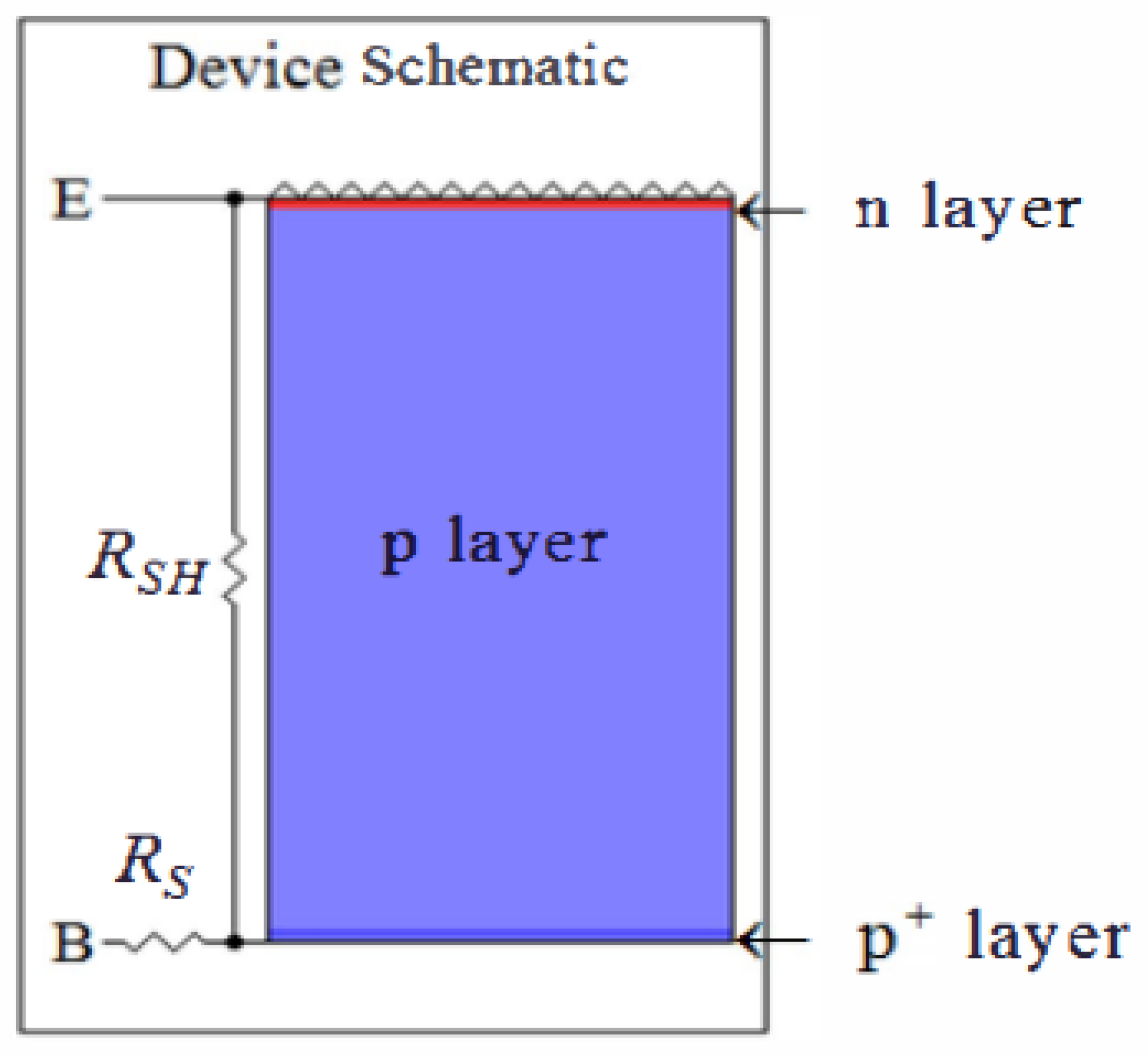
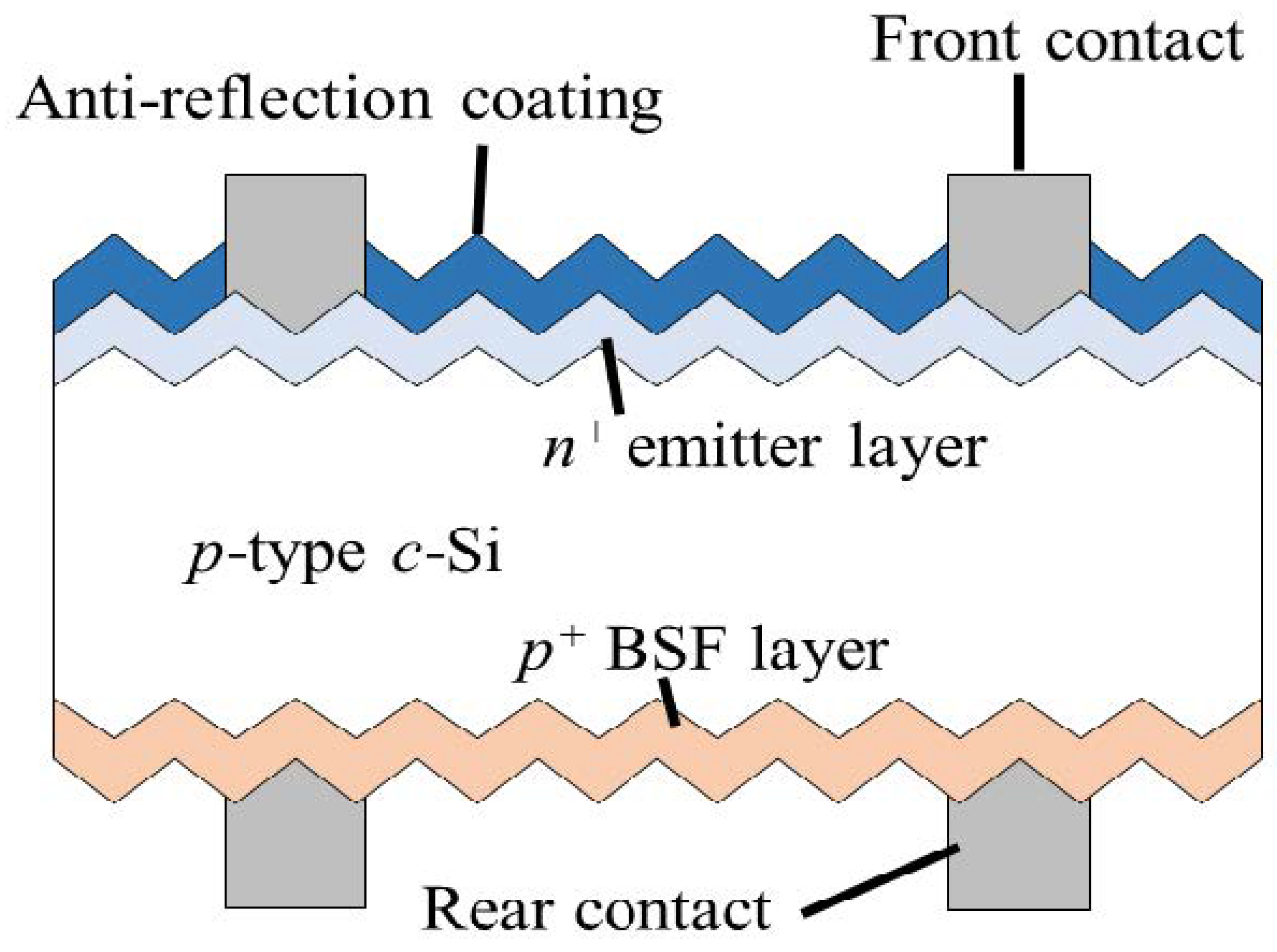

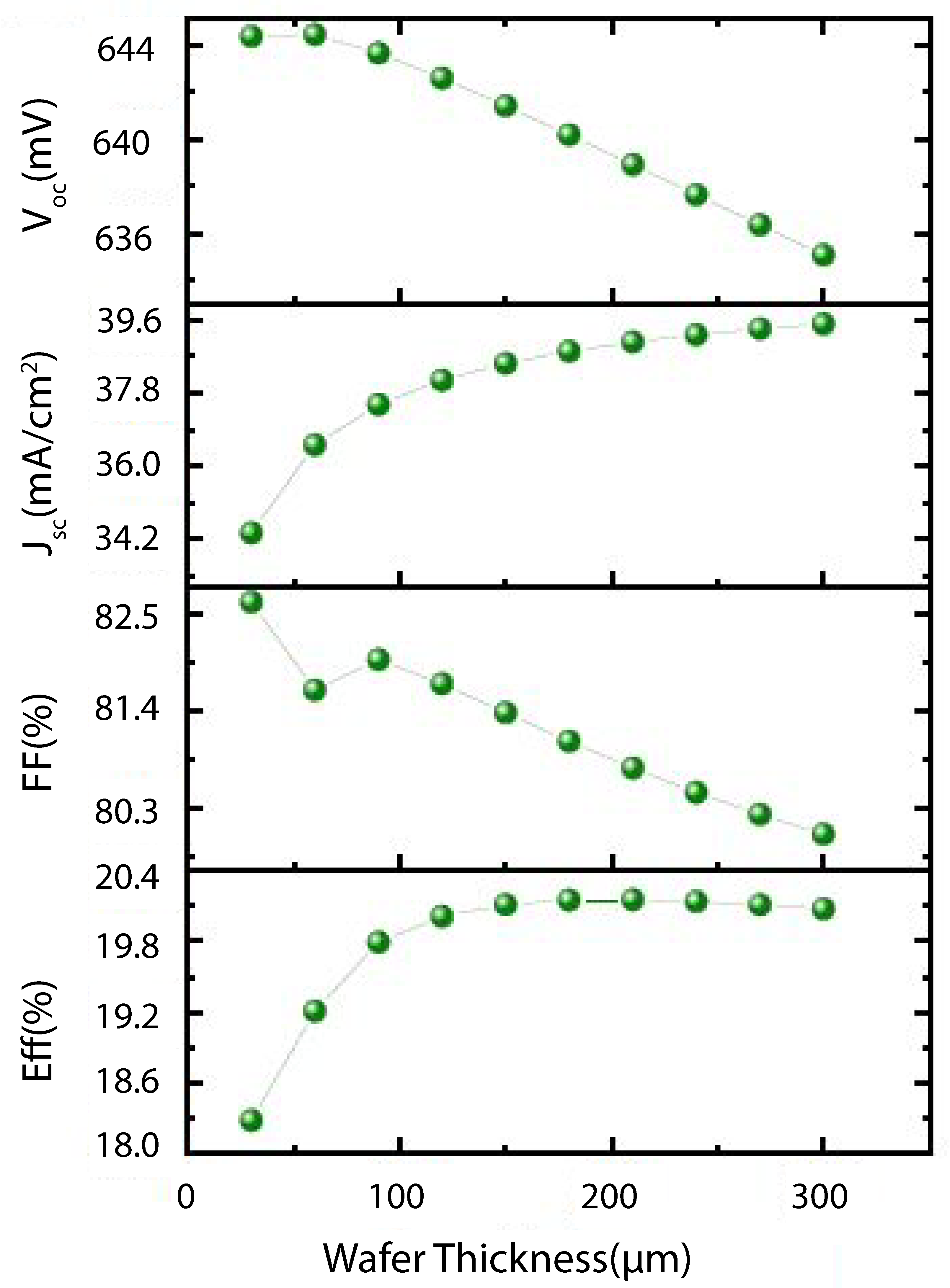

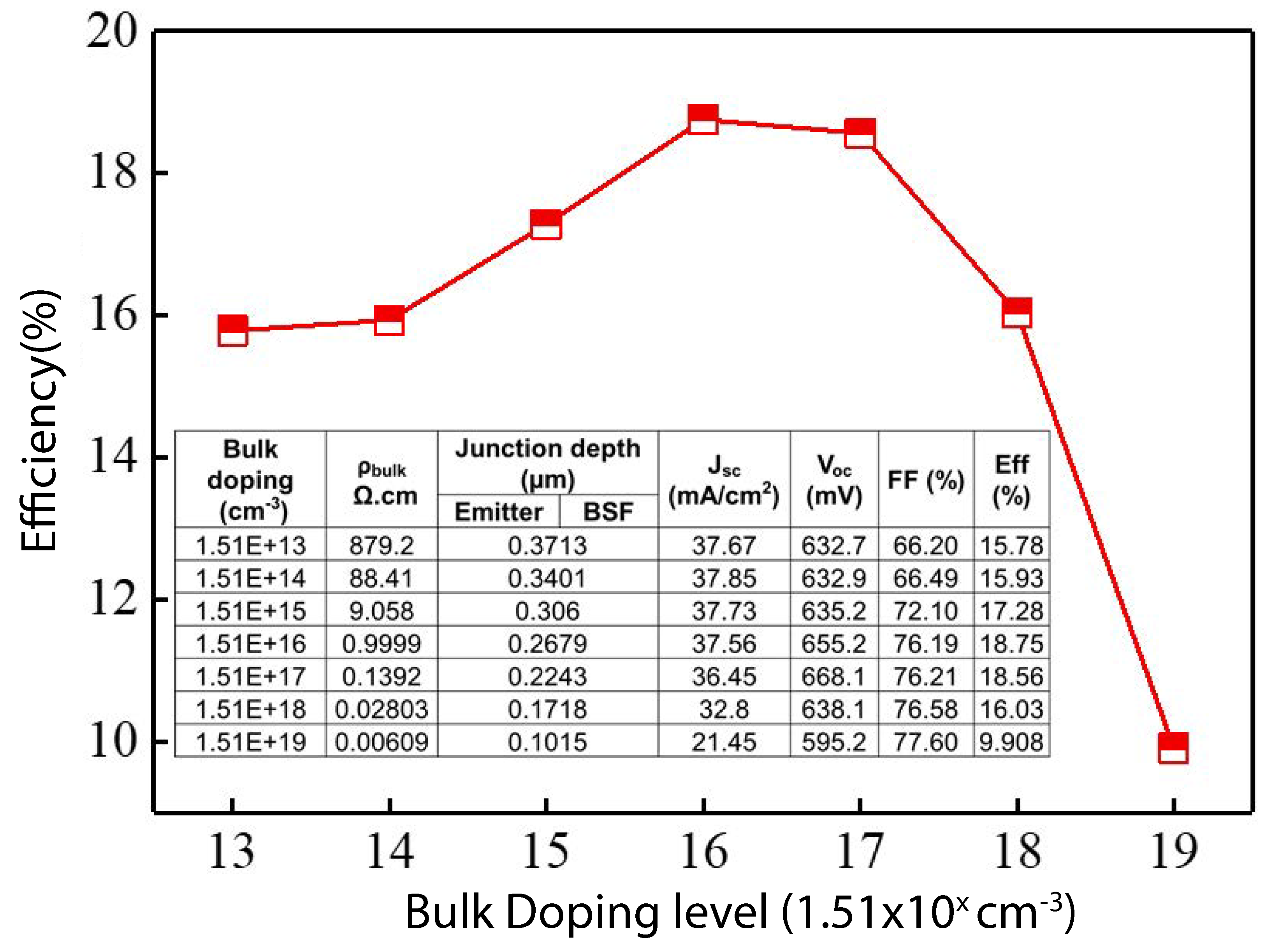
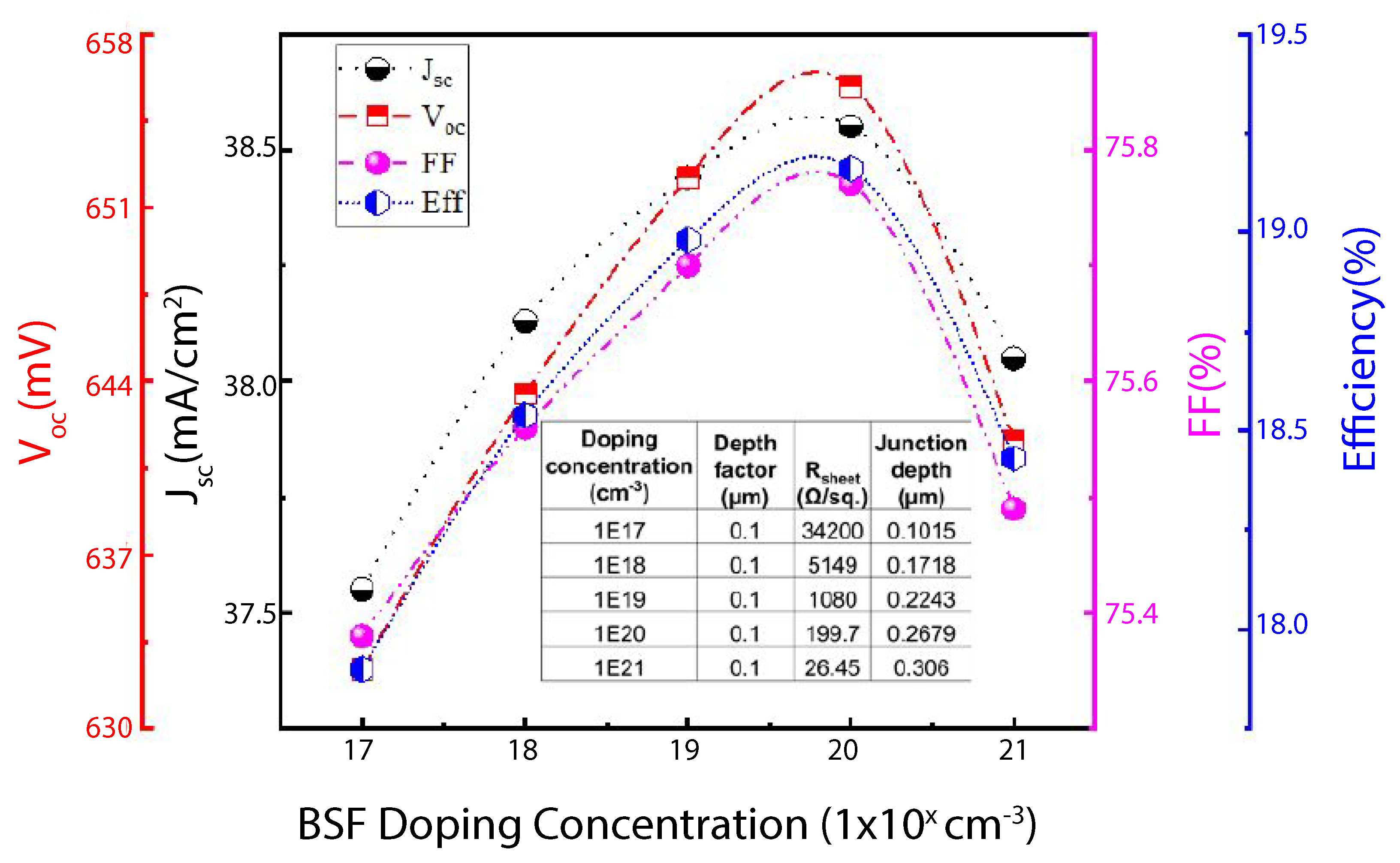
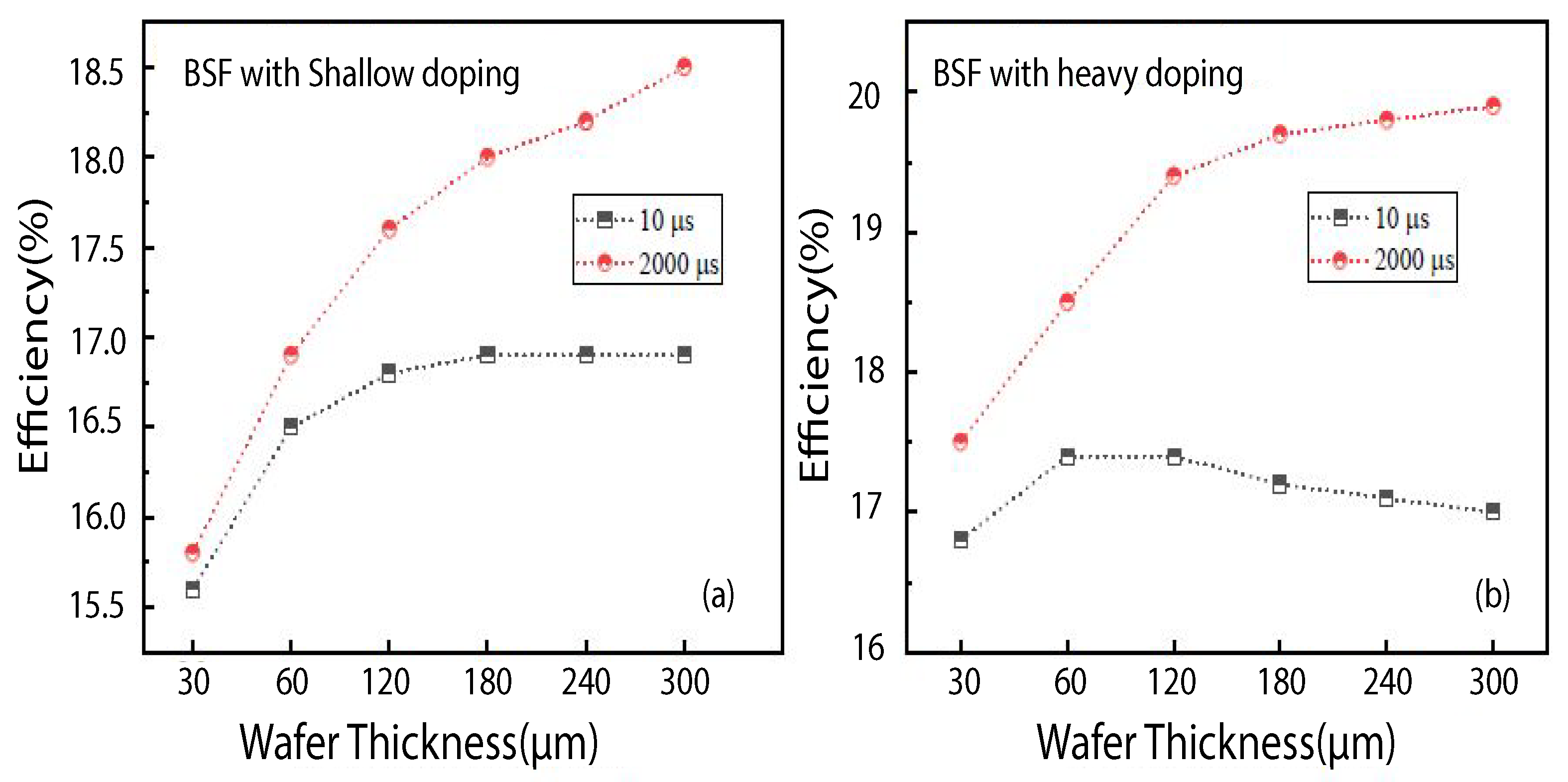
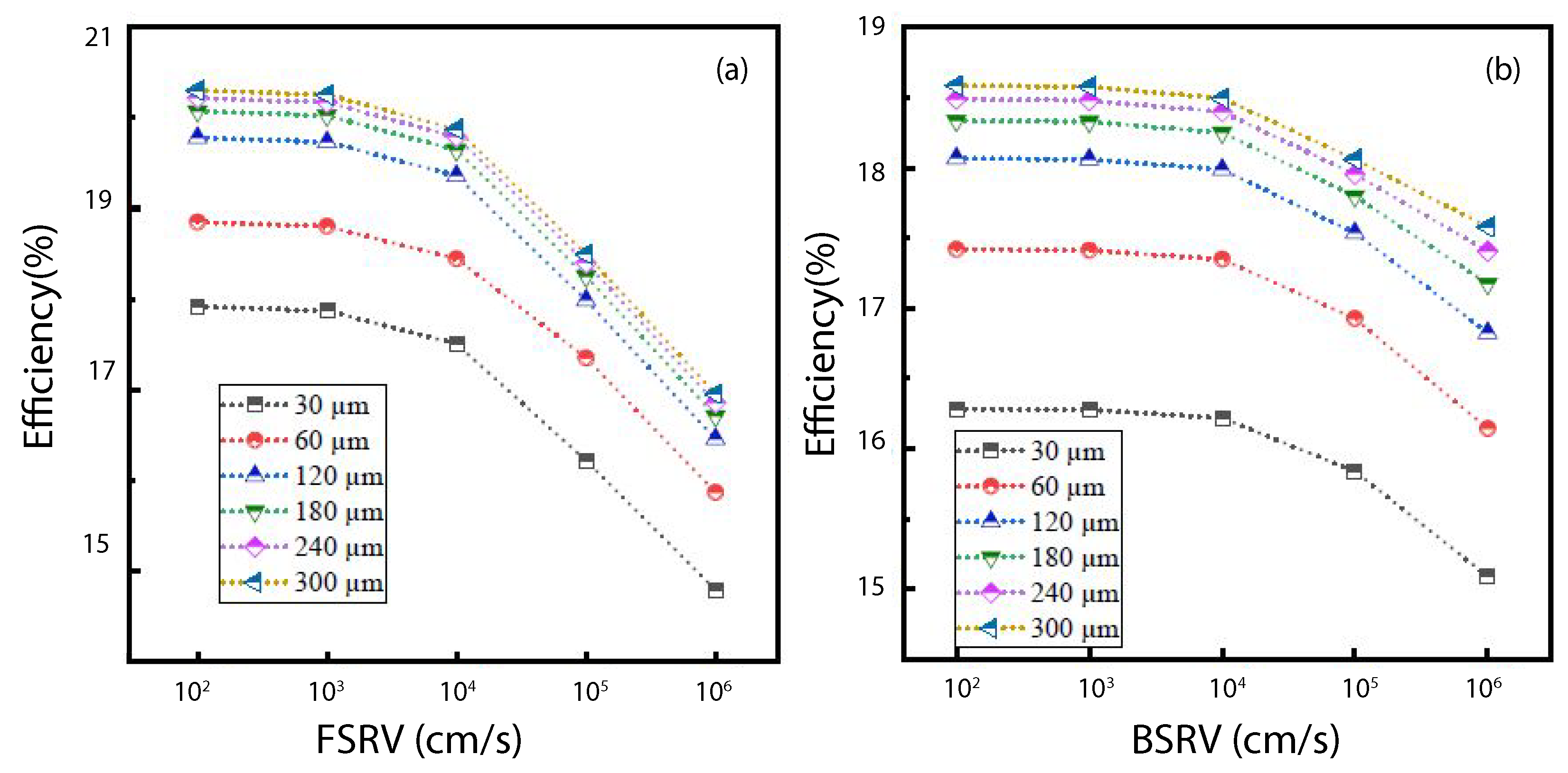
| S. No. | Software | Highlights | Ref. |
|---|---|---|---|
| 1 | SENTUARUS ATLAS MICROTEC | Sentuarus, atlas, and microtec are general-purpose device simulation tools in which specific parameters are adjusted for solar cell simulation. | [15,16,17,18] |
| 2 | SCAPID | SCAPID helps investigate the limits of the open-circuit voltage used to analyze conductivity modulation in concentrated cell configuration. | [19,20,21] |
| 3 | SEEMA | Solar-Cell Efficiency Estimation Methodology and Analysis (SEEMA) is one of the first process simulation tools combined with device simulation. | [22] |
| 4 | PISCES IIB | PISCES IIB is one of the earliest simulations of floating junctions which consisted of two-dimensional cell structures. | [23] |
| 5 | ADEPT | Two and three dimensions solar cell simulations were the standouts, in general, used for simulating silicon solar cells, which are made of materials other than crystalline silicon. | [24] |
| 6 | AFORSHET | AFORSHET is mainly used for heterostructure solar cells like crystalline wafers with amorphous layers. | [8,9] |
| 7 | FLOODS SIMUL DESSIS | FLOODS are object-oriented silicon solar cell simulation tool, uses the Monte Carlo simulation technique for performing transient analysis. SIMUL is used to analyze Si solar cells with record efficiency levels. DESSIS was applied to emitters with a mesh structure, thin cells on transparent substrates, and recently rear-contacted cells. | [2,25,26,27,28,29,30,31] |
| 8 | TCAD | Technology Computer-Aided Design is an electronic design automation tool that can be used to models semiconductor fabrication and semiconductor device operation. | [6,7] |
| 9 | Solar Eye | Solar Eye is a web-based PV software for remote monitoring and management of solar photovoltaic systems. It helps in simulating fault isolation, yield maximization, and return of investment. | [11,12,13] |
| 10 | Gridller | Gridller is a MATLAB plugin used to design, simulate, analyze, learn, and improve silicon solar cell performance. | [10] |
| 11 | Quokka | Quokka numerically solves the 1D/2D/3D silicon solar cell devices, and it is an integrated part of the PV lighthouse software package. | [14] |
| 12 | PC1D | The modeling tool with finite element methodology is well suited for 1D and 2D silicon cell simulations. PC1D outperforms the other tools regarding its speed, user interface, and continual updates to the latest cell models. PC1D can simulate new device performance and for new users to develop an understanding of device physics. | [3,4,5] |
| Characteristics | Value |
|---|---|
| Device area | 100 cm |
| Front/ rear surface texture depth | /3 m |
| Front/Rear surface coating | nm |
| Internal optical reflectance | Enabled |
| Thickness | 180 m |
| Intrinsic concentration ni @ 300 K | cm |
| diffusion | cm |
| diffusion | cm |
| Front and rear SRV | 10,000 cm/s |
| Bulk recombination | 100 s |
| Temperature | 25 °C |
Publisher’s Note: MDPI stays neutral with regard to jurisdictional claims in published maps and institutional affiliations. |
© 2021 by the authors. Licensee MDPI, Basel, Switzerland. This article is an open access article distributed under the terms and conditions of the Creative Commons Attribution (CC BY) license (https://creativecommons.org/licenses/by/4.0/).
Share and Cite
Thirunavukkarasu, G.S.; Seyedmahmoudian, M.; Chandran, J.; Stojcevski, A.; Subramanian, M.; Marnadu, R.; Alfaify, S.; Shkir, M. Optimization of Mono-Crystalline Silicon Solar Cell Devices Using PC1D Simulation. Energies 2021, 14, 4986. https://doi.org/10.3390/en14164986
Thirunavukkarasu GS, Seyedmahmoudian M, Chandran J, Stojcevski A, Subramanian M, Marnadu R, Alfaify S, Shkir M. Optimization of Mono-Crystalline Silicon Solar Cell Devices Using PC1D Simulation. Energies. 2021; 14(16):4986. https://doi.org/10.3390/en14164986
Chicago/Turabian StyleThirunavukkarasu, Gokul Sidarth, Mehdi Seyedmahmoudian, Jaideep Chandran, Alex Stojcevski, Maruthamuthu Subramanian, Raj Marnadu, S. Alfaify, and Mohd. Shkir. 2021. "Optimization of Mono-Crystalline Silicon Solar Cell Devices Using PC1D Simulation" Energies 14, no. 16: 4986. https://doi.org/10.3390/en14164986
APA StyleThirunavukkarasu, G. S., Seyedmahmoudian, M., Chandran, J., Stojcevski, A., Subramanian, M., Marnadu, R., Alfaify, S., & Shkir, M. (2021). Optimization of Mono-Crystalline Silicon Solar Cell Devices Using PC1D Simulation. Energies, 14(16), 4986. https://doi.org/10.3390/en14164986









